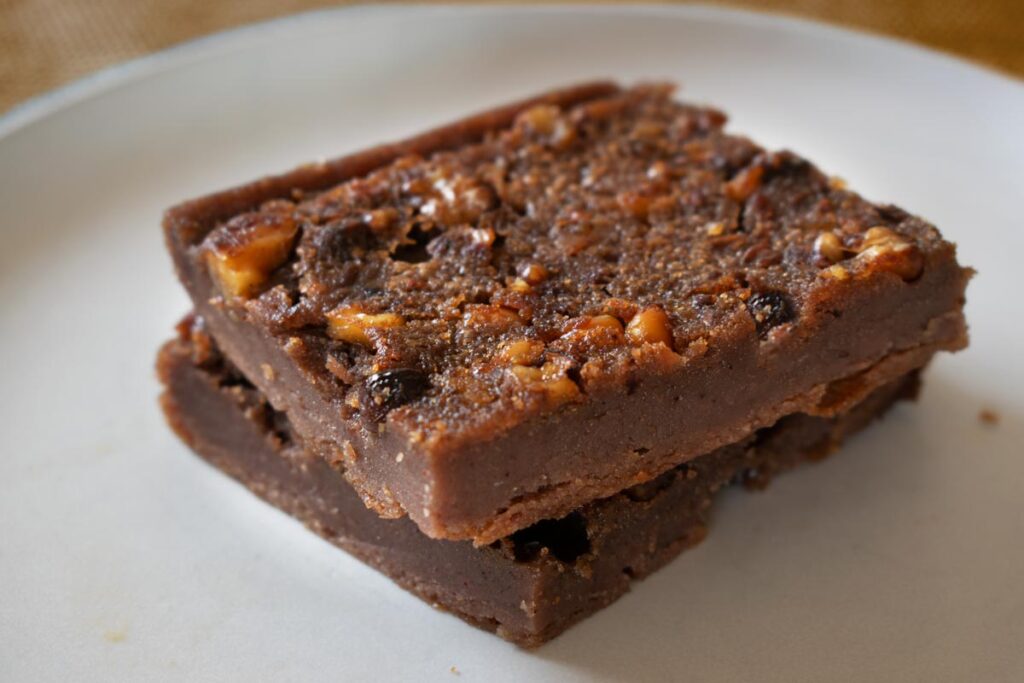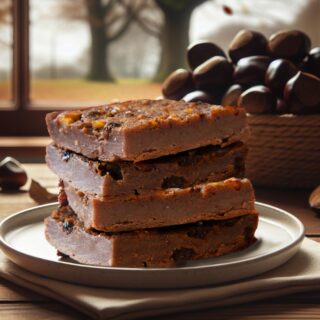Italian Chestnut cake, also known as “castagnaccio” in Italian, is a classic dessert from the regions near the Apennine Mountains. It is a very simple cake made primarily from chestnut flour and a few other ingredients, making it a quintessential autumn treat.
Chestnut cake, Castagnaccio, is a traditional Italian cake. It is moist and compact yet still pleasantly soft. It has a subtle yet distinctive flavor profile. To make chestnut cake, you will need chestnut flour as the primary ingredient. No leavening agents are needed, since chestnut flour produces a naturally dense cake. The batter is then baked in a flat pan until set. The finished chestnut cake should be moist but firm.
Castagnaccio is a traditional dessert that naturally vegan, without butter, eggs, milk, gluten or sugar: chestnut flour sweetens it naturally.
Since chestnuts, the key ingredient in this recipe, are very common in regions like Veneto, Piedmont, Lombardy, Emilia-Romagna and Tuscany, it can be difficult to pinpoint the true origin of chestnut cake. In reality, each region has its own version that is just as good as the others. One thing we do know is that this sweet treat has its roots in a very ancient past – just think that by the 1500s it was already well known and appreciated. Today I will present the most common version from my Region, Emilia-Romagna.
How To Make Italian Chestnut Cake
Ingredients:
- 650 g water (2¾ cups) + more to soak raisins and pine nuts
- 80 g sultana raisins (½ cup plus 1 tbsp)
- 60 g pine nuts (⅓ cup plus 2 tbsp)
- 500 g chestnut flour (5½ cups plus 1 tbsp)
- 50 g (3 tbsp plus 1 tsp) extra virgin olive oil
- A pinch of salt
PRO TIP — If you can’t buy it in a store near your home or online, you can prepare chestnut flour yourself by following this tutorial.
Step-by-step Instructions:
First, place the raisins and pine nuts in a bowl and cover with warm water. Let soak for 10 minutes. This will plump them up nicely.
In a large mixing bowl, combine the sifted chestnut flour with 650 g water and a pinch of salt. Mix thoroughly until there are no lumps. Now stir in 40 g of olive oil until fully combined.
At this point, oil a low round cake tin with a diameter of 32 cm (13 inch). Pour the chestnut flour mixture into the prepared pan, smoothing it out evenly to a thickness of about 1/2 inch. Scatter the soaked raisins and pine nuts evenly over the top. Drizzle with a bit more olive oil.
Bake at 200 °C (392 °F) for about 20 minutes, or until lightly golden around the edges. Remove from oven and cool completely before cutting into squares.
While not the most attractive dessert visually, I assure you it is worth a taste. The flavors of chestnut and olive oil come through in each bite of this uniquely vegan treat.

When Serve Chestnut Cake
This unique cake is an excellent source of energy and beneficial nutrients found in chestnut flour, such as minerals and vitamins. Because of this, it is ideal to enjoy for breakfast to start your day with a healthy boost of energy. A slice of chestnut cake also makes a satisfying snack on a cool fall afternoon.
Italian Chestnut Cake Storage Instructions
Castagnaccio will keep fairly well stored in an airtight container in the refrigerator for about a week. It can also be stored at room temperature in an airtight metal tin for 3–4 days. For long term storage, Castagnaccio can be frozen. While not ideal, freezing Castagnaccio is an option for keeping it on hand if you won’t eat it right away. In the freezer wrapped well, it can potentially last a couple months. Just thaw it overnight in the fridge before serving.
Choosing the Right Wine for Chestnut Cake
When enjoying chestnut cake, you’ll want a wine that can truly complement the flavors. For the best pairing, look for a sweet wine from the same region. A great option is Romagna Albana passito from Emilia-Romagna. The Vin Santo Occhio di Pernice or Aleatico dell’Elba passito are also excellent matches. Umbria has some great possibilities too, starting with Sagrantino di Montefalco passito. Give the Recioto della Valpolicella a try as well. And why not enjoy it with a glass of Barolo chinato? This combination is a true celebration of autumnal flavors.

How to Make Chestnut Cake (Castagnaccio), a Traditional Vegan Autumn Treat
Equipment
- 1 Round cake pan (13 inch)
Ingredients
- 650 g water + more to soak raisins and pine nuts
- 80 g sultana raisins
- 60 g pine nuts
- 500 g chestnut flour
- 50 g extra virgin olive oil
- A pinch of salt
Instructions
- First, place the raisins and pine nuts in a bowl and cover with warm water. Let soak for 10 minutes. This will plump them up nicely.
- In a large mixing bowl, combine the sifted chestnut flour with 650 g water and a pinch of salt. Mix thoroughly until there are no lumps. Now stir in 40 g of olive oil until fully combined.
- At this point, oil a low round cake tin with a diameter of 32 cm. Pour the chestnut flour mixture into the prepared pan, smoothing it out evenly to a thickness of about 1/2 inch. Scatter the soaked raisins and pine nuts evenly over the top. Drizzle with a bit more olive oil.
- Bake at 200 °C for about 20 minutes, or until lightly golden around the edges. Remove from oven and cool completely before cutting into squares.







